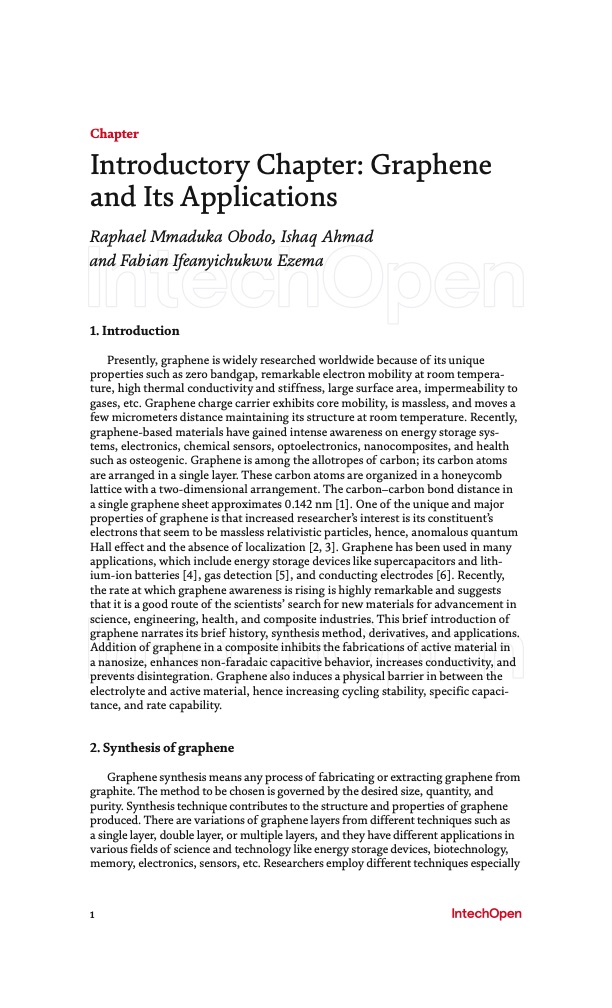
PDF Publication Title:
Text from PDF Page: 003
Chapter Introductory Chapter: Graphene and Its Applications Raphael Mmaduka Obodo, Ishaq Ahmad and Fabian Ifeanyichukwu Ezema 1. Introduction Presently, graphene is widely researched worldwide because of its unique properties such as zero bandgap, remarkable electron mobility at room tempera- ture, high thermal conductivity and stiffness, large surface area, impermeability to gases, etc. Graphene charge carrier exhibits core mobility, is massless, and moves a few micrometers distance maintaining its structure at room temperature. Recently, graphene-based materials have gained intense awareness on energy storage sys- tems, electronics, chemical sensors, optoelectronics, nanocomposites, and health such as osteogenic. Graphene is among the allotropes of carbon; its carbon atoms are arranged in a single layer. These carbon atoms are organized in a honeycomb lattice with a two-dimensional arrangement. The carbon–carbon bond distance in a single graphene sheet approximates 0.142 nm [1]. One of the unique and major properties of graphene is that increased researcher’s interest is its constituent’s electrons that seem to be massless relativistic particles, hence, anomalous quantum Hall effect and the absence of localization [2, 3]. Graphene has been used in many applications, which include energy storage devices like supercapacitors and lith- ium-ion batteries [4], gas detection [5], and conducting electrodes [6]. Recently, the rate at which graphene awareness is rising is highly remarkable and suggests that it is a good route of the scientists’ search for new materials for advancement in science, engineering, health, and composite industries. This brief introduction of graphene narrates its brief history, synthesis method, derivatives, and applications. Addition of graphene in a composite inhibits the fabrications of active material in a nanosize, enhances non-faradaic capacitive behavior, increases conductivity, and prevents disintegration. Graphene also induces a physical barrier in between the electrolyte and active material, hence increasing cycling stability, specific capaci- tance, and rate capability. 2. Synthesis of graphene Graphene synthesis means any process of fabricating or extracting graphene from graphite. The method to be chosen is governed by the desired size, quantity, and purity. Synthesis technique contributes to the structure and properties of graphene produced. There are variations of graphene layers from different techniques such as a single layer, double layer, or multiple layers, and they have different applications in various fields of science and technology like energy storage devices, biotechnology, memory, electronics, sensors, etc. Researchers employ different techniques especially 1PDF Image | Graphene and Its Applications

PDF Search Title:
Graphene and Its ApplicationsOriginal File Name Searched:
GrapheneChapterPublished.pdfDIY PDF Search: Google It | Yahoo | Bing
Salgenx Redox Flow Battery Technology: Power up your energy storage game with Salgenx Salt Water Battery. With its advanced technology, the flow battery provides reliable, scalable, and sustainable energy storage for utility-scale projects. Upgrade to a Salgenx flow battery today and take control of your energy future.
| CONTACT TEL: 608-238-6001 Email: greg@infinityturbine.com | RSS | AMP |